
Что такое книга заявок? Определение и как она работает
В статье
Книга заказов является жизненно важным компонентом в ландшафте финансовой торговли. Он предоставляет подробную бухгалтерскую бухгалтерскую книгу о покупке и продаже заказах за ценные бумаги или финансовые инструменты, организованные по уровню цен. Показывая глубину рыночного спроса по нескольким ценовым пунктам, этот электронный список повышает прозрачность рынка и дает представление о количестве предложений или предлагаемых акций. Трейдеры и инвесторы, надеющиеся сделать интеллектуальный выбор в динамичных мирах акций, облигаций и валют, должны сначала понять, как работает книга заказа.
Определение книги заказа
| Сторона | Цена | Количество | Описание |
| Ставка (купить) | 101.20 | 500 | Покупатели самой высокой цены готовы заплатить |
| Ставка (купить) | 101 | 350 | Следующий уровень покупателя |
| Спросите (продай) | 101.40 | 600 | Продавцы с самыми низкими ценами готовы платить |
| Спросите (продай) | 101.60 | 450 | Следующий уровень продавца |
Запись в прямом эфире покупать и продавать заказы на рынке для определенного класса активов - стука, облигации, валют или криптовалюты - книга заказов - это необходимый инструмент, который способствует прозрачной торговле. Основная цель книги заказа-динамическая запись и организовать данные в режиме реального времени по покупке и продаже цены и количества заказа. Это непрерывное обновление предоставляет трейдерам и инвесторам четкий, непосредственный снимок динамики спроса и предложения рынка.
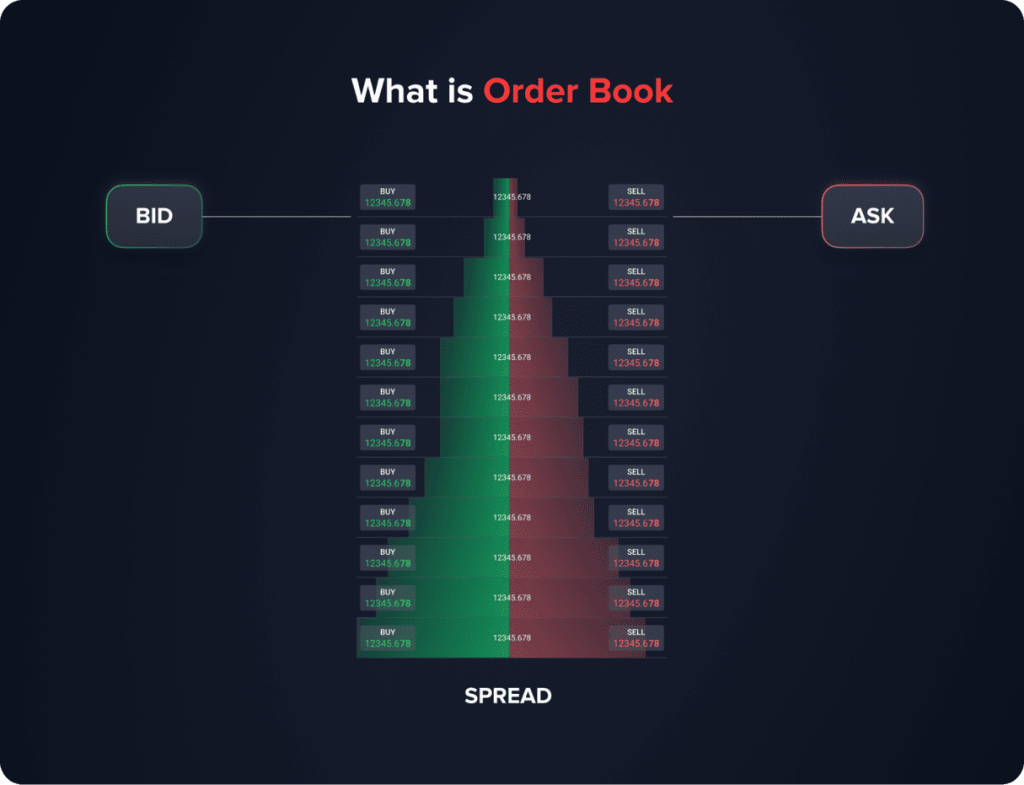
Обычно показывают друг друга в табличном стиле, заказы на покупку и продажу имеют свои соответствующие цены, расположенные либо в восходящей, либо в снижении последовательности. Например, заказы на покупку, или предложения, сначала размещены по самой высокой цене; Продать заказы или спрашивает, сначала покажите самую низкую цену. Эта договоренность предлагает четкое визуальное представление о активности рынка и настроениях, направляющих стратегии торговли. Отражая конкретный уровень цен, каждая строка показывает количество акций или единиц, доступных на этом уровне, что предоставляет информацию о глубине и ликвидности рынка. «Распространение», различия между самой высокой ставкой и самой низкой задачей, оказывается довольно хорошим показателем волатильности и эффективности рынка.
You may also like
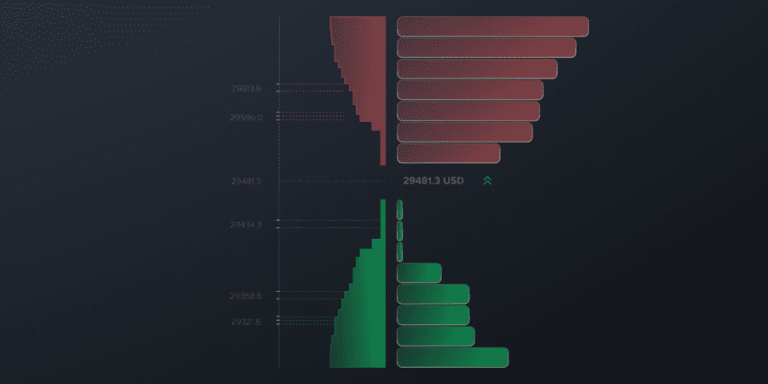
Типы заказов в книге
Заказы в книге заказа могут быть либо рыночными, либо ограниченными заказами. Рыночные заказы немедленно выполняются по лучшей доступной цене, затрагивая «вершину книги». Напротив, ограниченные заказы выполняются по определенной цене или лучше, что заполняет сторону покупки или продажи книги в соответствии с предпочтениями трейдера.
Типы книг заказа
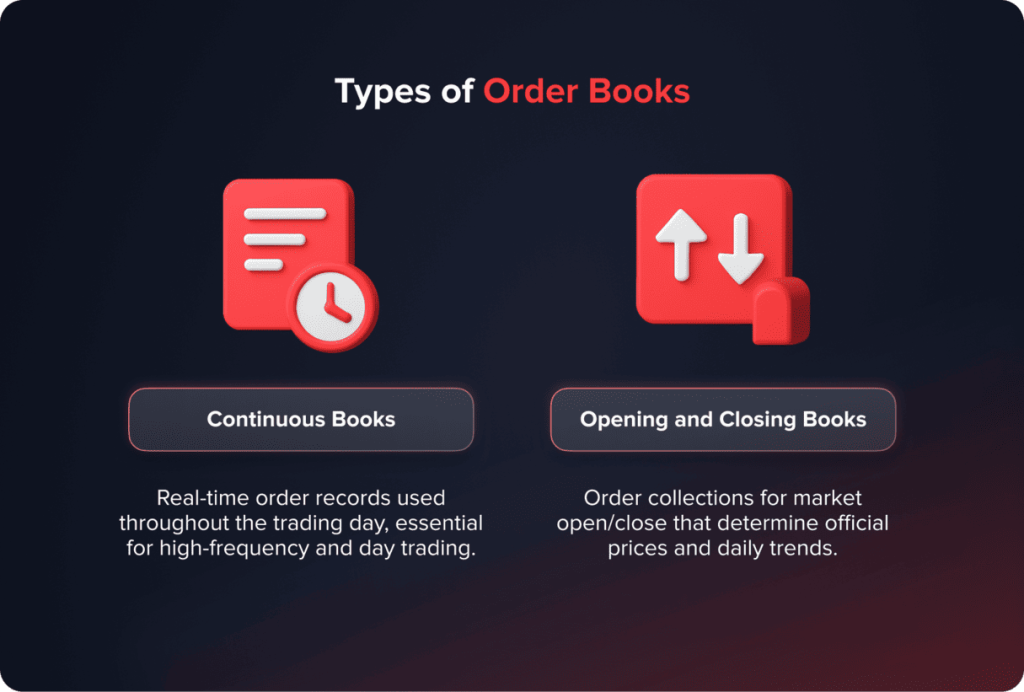
Заказы книг можно разделить на две основные категории на основе времени выполнения заказа:
- Непрерывные книги: Они обновляются в режиме реального времени на протяжении всего торгового дня, обеспечивая постоянные изменения рыночных изменений. Они отражают каждый входящий и исходящий порядок, предлагая всесторонний обзор развивающегося состояния рынка. Этот тип широко используется в большинстве электронных обменов, таких как NASDAQ или NYSE, и имеет важное значение для высокочастотной торговли и дневной торговли.
- Открытие и закрытие книг: Эти типы книг содержат заказы, специально предназначенные для выполнения на открытии или закрытии рынка соответственно. Заказы в этих книгах поддерживаются отдельно до тех пор, пока не будут консолидированы с непрерывной книгой на открытии и закрытии рынка, чтобы создать официальные цены на открытие и закрытие. Эти цены жизненно важны для оценки портфеля и принятия стратегических решений, поскольку они указывают на ежедневные рыночные тенденции.
Структуры книг заказа могут значительно различаться на мировых финансовых рынках. Например, фондовые биржи в США в основном используют книги электронных заказов, в то время как некоторые азиатские рынки по -прежнему включают гибридные аукционные системы. В торговле на Форекс нет централизованной книги по заказу из -за децентрализованного характера валютных рынков, поэтому трейдеры полагаются на агрегированную ликвидность из нескольких источников. Обмены криптовалюты часто работают с другой подходящей логикой двигателя, что позволяет создавать такие функции, как децентрализованные книги заказов в одноранговых торговых средах. Понимание этих вариаций имеет решающее значение для трейдеров, работающих в нескольких классах активов или на глобальных рынках.
Альтернативные структуры книги заказа
В дополнение к обсуждаемым стандартным моделям существуют различия в порядок структур книг, которые удовлетворяют различные потребности и стратегии рынка.
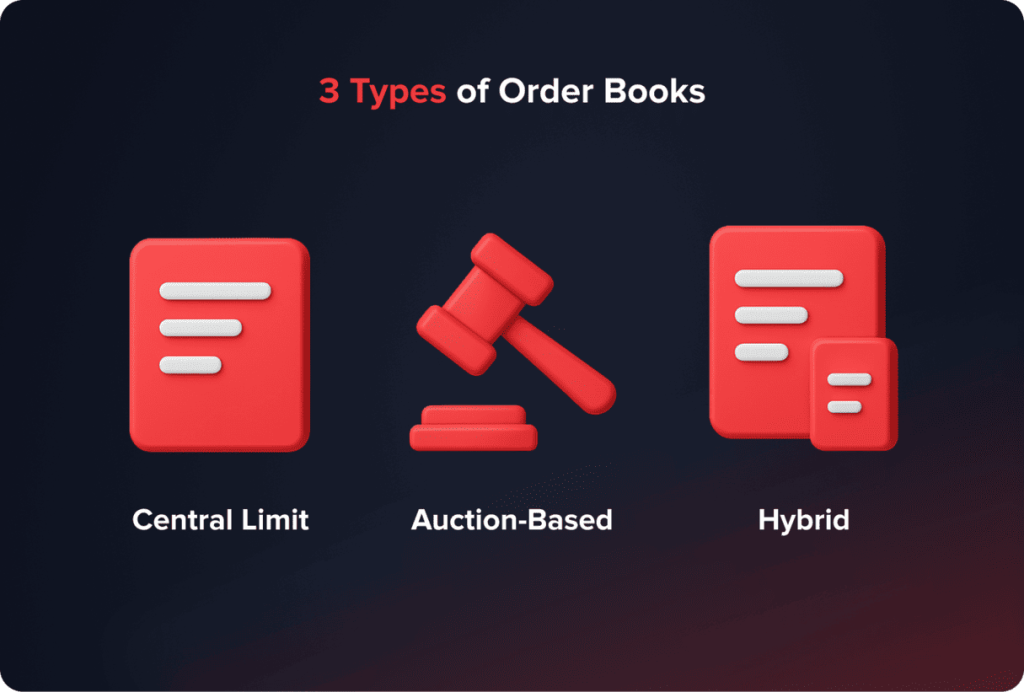
- Книга центрального предельного порядка (Clob): Клеб - это самая распространенная форма книги заказа, централизация заказов на покупку и продажу, чтобы облегчить открытие цены. Он широко используется на биржах для объединения всех видимых заказов, предоставляя всестороннюю информацию о рынке. Тем не менее, его прозрачность может препятствовать некоторым институциональным трейдерам из -за потенциального влияния на рынок.
- Аукционная книга заказов: Обычно используется во время открытия и закрытия рынка, этот тип книги заказов накапливает заказы в течение определенного периода времени, соответствующего их процессу аукциона по одной равновесной цене. Он обеспечивает контролируемую торговую среду, смягчая волатильность, обеспечивая при этом эффективные цены.
- Гибридная книга заказов: Гибридный подход объединяет клоб с такими функциями, как скрытые заказы или различные приоритеты выполнения. Это позволяет биржам для размещения различных торговых предпочтений, что обеспечивает гибкость для институциональных инвесторов, высокочастотных трейдеров и участников розничной торговли.
Дополнительные соображения
Заказы могут также включать в себя скрытые или айсбергские заказы, в которых показана всего лишь часть всей суммы, а остальное выставлено после завершения первой части. Эта функция позволяет институциональным инвесторам разместить крупные заказы без существенного влияния на рыночные цены. Доступность нескольких типов заказа и процедур выполнения подчеркивает необходимость знать, как книги заказа работают для любого серьезного трейдера или инвестора.
Как трейдеры используют книги заказа (варианты использования)
Заказы книг - это не просто технические данные: это практические инструменты, которые трейдеры используют для руководства своими решениями.
1. Скальпирование и внутридневная торговля
Краткосрочные трейдеры используют книгу заказа, чтобы определить предстоящие изменения в ликвидности или массовых скрытых заказов. Например, рост заказов на покупку по ключевой цене может сигнализировать о неизбежном отскоке.
2. Определение поддержки и сопротивления
Уровни поддержки создаются полосами заказов на покупку, а сильные заказы на продажу представляют собой сопротивление. Трейдеры помещают записи/выходы возле этих уровней.
Пример: трейдер видит 10 000 заказов на покупку eth в размере 2000 долларов США => интерпретации в качестве поддержки и помещает остановку ниже.
3. Время выхода на рынок
Посмотрите на дисбаланс заказа (больше заявок, чем просят), чтобы оценить краткосрочные настроения - бык или медведь.
4. Проверка ликвидности
Дневные торговцы избегают тонких книжных инструментов (широких спредов) и обращаются к жидким рынкам с хорошим исполнением.
5. Большое торговое исполнение
Учреждения используют такие стратегии, как заказы айсберга, чтобы избежать раскрытия полноразмерного размера. Пример: разделение заказа на 10 миллионов долларов на небольшие видимые укусы.
Как работают книги по заказу
Книга заказов содержит организованный снимок текущего состояния рынка путем классификации и отображения различных разделов торговой информации.
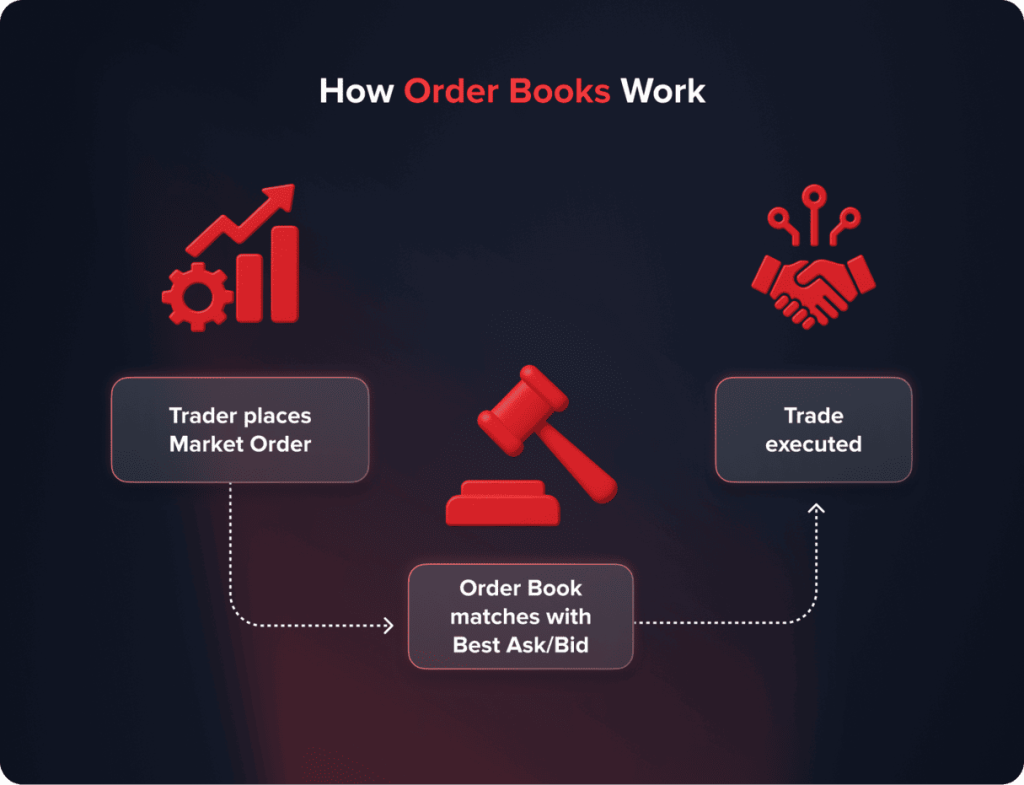
Купить заказы (ставки)
Начиная с самой высокой цены, покупатель готов заплатить за определенный актив, заказы на покупку - также известные как предложения - представленные проценты покупателей и размещаются в снижении заказа. Эти предложения соответствуют желаемому количеству покупки. В разделе ставки выявлены уровни спроса в различных ценах и дают представление о аппетите покупки актива.
Продавать заказы (спрашивает)
Продать заказы или спрашивает, представляют предложения продавцов и расположены в восходящем заказе, начиная с самой низкой цены, по которой продавец готов продать. Как и заявки, каждый вопрос сопровождается соответствующим объемом, выявляя уровни поставок по различным ценовым пунктам. Раздел «Ас» иллюстрирует, сколько актива доступна для продажи и по какой цене, что дает представление о давлении продаж.
История заказа
Раздел «История заказа» записывает все ранее завершенные транзакции, представляющие исторический отчет о исполненных сделках и их соответствующих ценах и объемах. Эти исторические данные помогают трейдерам анализировать тренды в прошлые цены и торговое поведение, чтобы выявить закономерности или предсказать будущие движения рынка.
Анализ книги заказа играет решающую роль в понимании глубины рынка (DOM) и потока порядка. Трейдеры используют DOM для оценки ликвидности на различных уровнях цен, предоставляя представление о спросе и предложении за пределами высшей заявки и спрашивают цены. Анализ потока заказа, с другой стороны, помогает трейдерам определять направление рынка, отслеживая крупные заказы, агрессивные покупки/продажи и сдвиги импульса. Многие профессиональные трейдеры используют стратегии средней цены (VWAP) для эффективного выполнения крупных сделок без значительного влияния на движения цен.
Динамика рынка и индикаторы
В книге заказов взаимосвязь между заказывами на покупку и продажу раскрывает важную динамику рынка и предлагает ценные показатели для трейдеров и инвесторов.
- Вершина книги: Самая высокая цена ставки и самая низкая цена Ask Shape «Top of the Book», которая отображает наиболее конкурентоспособную покупку и продажу цен, доступных в любой момент. Эти ставки являются жизненно важными маркерами состояния рынка, которые позволяют трейдерам быстро оценивать спрос и условия предложения.
- Bid-Ask Spress: Разница между самой высокой ценой ставки и самой низкой ценой Ask известна как спред Bad-Ask. Этот распространение is a key metric for understanding market liquidity. A narrow распространение typically indicates high liquidity and lower trading costs, while a wider распространение signals lower liquidity and higher transaction costs.
- Уровни поддержки и сопротивления: Уровни поддержки и сопротивления относятся к ценовым диапазонам, где рынок, вероятно, покажет заметное давление на покупку или продажу. Большие кластеры заказов на покупку по определенной цене часто предполагают сильный уровень поддержки, что указывает на потенциальную стабильность в снижении цен. И наоборот, концентрация заказов на продажу по определенной цене или рядом с ним сигнализирует уровень сопротивления, потенциально ограничивая движения цен вверх.
- Порядок дисбаланса: Существенный дисбаланс в заказе на покупку и продажу может указывать на краткосрочные изменения рынка. Например, дисбаланс в пользу заказов на покупку может указывать на оптимистичные чувства, в то время как избыток заказов на продажу может указывать на пессимистические чувства. Определение этих дисбалансов позволяет трейдерам предвидеть возможные сдвиги цен.
В то время как книги заказов повышают прозрачность, они также подвержены методам манипуляции на рынке, такими как подделка и наслоение. Ссылка включает в себя размещение больших заказов без намерения выполнения, чтобы создать ложное впечатление о спросе или предложении, что влияет на рыночные настроения. Слои - это аналогичная тактика, где трейдеры размещают несколько поддельных заказов на разных уровнях цен для создания искусственного движения, прежде чем отменить их. Регуляторы, в том числе SEC и CFTC, увеличили наблюдение и навязали тяжелые штрафы на торговцев, пойманных в такую обманчивую практику.
Статистика книг заказа, такая как глубина рынка и спреды, не являются теоретической статистикой - правильно поняты, они указывают нам, насколько стрессовые рынки. Например, ФРС исследования на рынке казначейства США Предполагается, что во время кризиса ликвидности марта 2020 года глубина рынка провалилась на этаж, в то время как воздействие на цену выбивалось, что значительно увеличило затраты на выполнение даже на самом рынке ликвидных облигаций в мире.
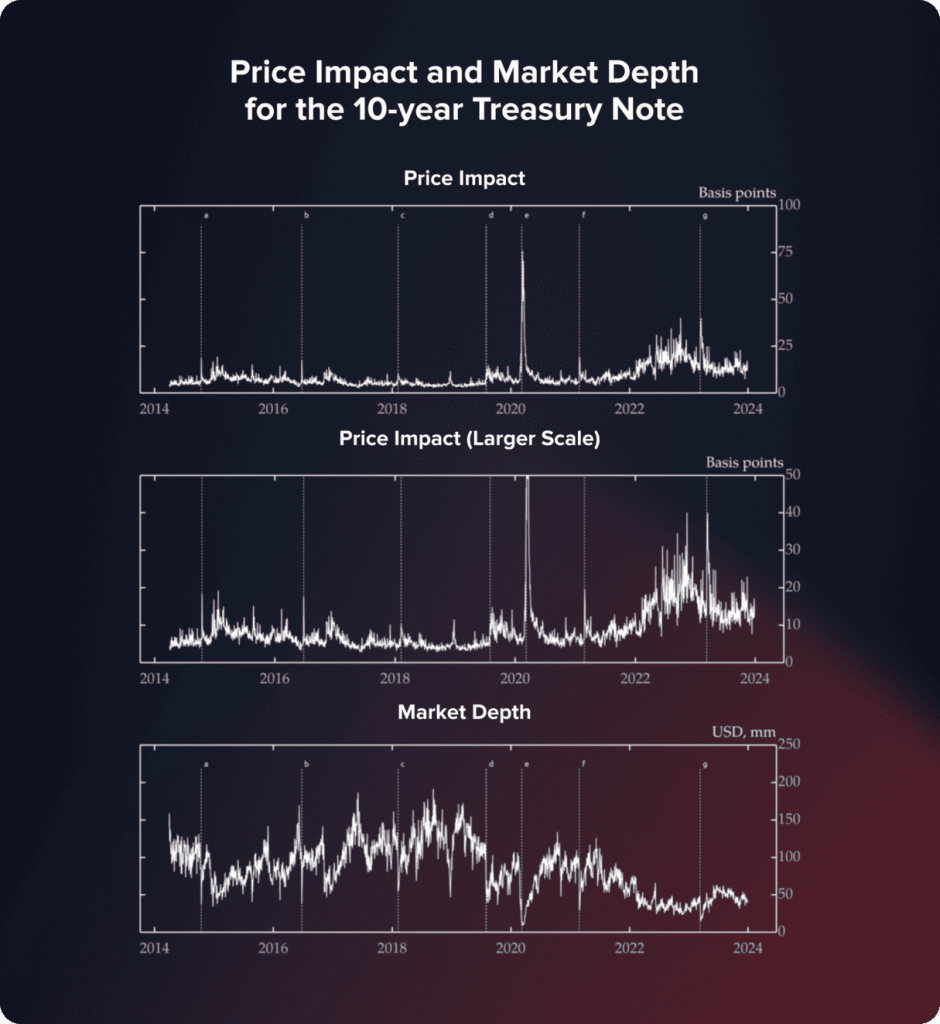
Источник:Федеральная резервная система, репо -интернационное сообщество брокеров; Расчеты авторов.
Технология и эволюция книг заказов
Цифровая революция на финансовых рынках изменила то, как функционируют книги по заказу, значительно повышая их эффективность и глубину. Одним из выдающихся развития является принятие алгоритмической торговли.
Инфографика временной шкалы здесь:
- Ручной торговый пол (до 1980-х годов)-бумажные голосовые брокеры.
- Книги электронных заказов (1980–1990 -х) - NASDAQ, Ранняя автоматизация.
- Алгоритмическая торговля (2000 -е годы) - более быстрое выполнение, системы, основанные на правилах.
- Высокочастотная и AI (2010S)-Торговля на микросекундном уровне, прогнозирующие модели.
- Блокчейнские книги заказа (2020 -е годы) - Децентрализованные, защищенные от платля.
Усовершенствованные алгоритмы выполняют заказы невероятно быстро и эффективно, анализируя данные заказа в реальном времени, чтобы определить шаблоны, оптимизировать время торговли и управлять рисками. Этот технологический прорыв привел к росту высокочастотной торговли, где алгоритмы используют мельчайшие движения цен для стратегических сделок.
Другим прогрессом является интеллектуальная маршрутизация заказа (SOR). SOR Systems сканирует и сравнивает цены и ликвидность на нескольких торговых площадках, направляя заказы на достижение оптимального выполнения. SOR Systems позволяет трейдерам использовать расхождения в ценах и получить доступ к скрытой ликвидности на фрагментированных рынках путем беспрепятственной интеграции данных из различных книг заказа.
Используя машинное обучение для изучения данных о книгах прошлых заказов и будущих проектов будущих цен, искусственный интеллект (ИИ) также меняет подходы к торговле. В частности, при оценке краткосрочного настроения на рынке или проецирования изменений в ликвидности эта прогнозирующая способность позволяет трейдерам принимать более образованные решения.
Отслеживая заказы в качестве неизменных событий, Blockchain Technology предлагает распределенную замену традиционных бирж с открытыми и защищенными за заказоми книгами. Поскольку это изобретение поддерживает безопасную торговую инфраструктуру по всему миру, оно становится все более и более важным на криптовалютных рынках.
Эти технические разработки сделали книги заказа более динамичными и отзывчивыми, давая трейдерам ранее неслыханное понимание рыночных движений. Предвидение рыночных изменений и улучшение торговых методов зависят от осознания этих изменений, что поможет трейдерам оставаться конкурентоспособными в быстро меняющейся финансовой среде сегодня.
Машинное обучение и аналитика больших данных имеют значительно улучшенный анализ книг заказа. Торговые алгоритмы, основанные на AI, теперь могут обрабатывать огромные данные исторических данных книг заказа, чтобы обнаружить скрытые закономерности и прогнозировать краткосрочные движения цен с высокой точностью. Эти достижения привели к прогнозирующим рыночным моделям, которые динамически оптимизируют спреды с предложениями, повышая эффективность выполнения. Высокочастотные трейдеры и хедж-фонды в значительной степени полагаются на эти технологии, чтобы получить конкурентное преимущество в торговле на уровне микросекунды.
Особые соображения
Книга заказов имеет существенные ограничения, даже если она предназначена для улучшения открытости на финансовых рынках. Многие институциональные торговые мероприятия проводятся в «темных пулах», конфиденциальных торговых площадках, где крупные институциональные инвесторы могут покупать и продавать ценные бумаги, не раскрывая свои намерения на более широком рынке до после завершения продажи. Темные пулы позволяют этим инвесторам осуществлять значительные транзакции, с небольшим влиянием на рыночные цены, поскольку показание этих крупных заказов на общественных рынках приведет к манипулированию ценом или упреждающей торговле, что может снизить возможную стоимость их сделок.
Тем не менее, темные пулы ограничивают полезность книги заказов, поскольку данные об общественном обмене не полностью представляют фактическое спрос и предложение для конкретной безопасности. Отсутствие видимости может скрывать потенциальные ценовые движения или тенденции, которые трейдеры могли бы обнаружить в результате анализа только данных об общественном порядке.
Темные пулы играют значительную роль в современной торговле, учитывая значительный процент ежедневного объема на основных рынках. В то время как они предоставляют такие преимущества, как снижение проскальзывания цен и анонимность для институциональных инвесторов, они также представляют опасения по поводу прозрачности цен. Некоторые регулирующие органы установили правила, чтобы ограничить активность темного пула или требуют отчетности данных после торговли для обеспечения справедливой конкуренции на рынке. Кроме того, трейдеры используют заказы айсберга - где видна лишь небольшая часть общего порядка - для навигации по вопросам ликвидности при выполнении крупных сделок.
Утилита для трейдеров
Для трейдеров, особенно тех, кто участвует в высокочастотной или дневной торговле, книга заказов, тем не менее, является бесценным инструментом, несмотря на его ограничения. Глубина информации в книге заказа помогает трейдерам делать мудрые выборы в зависимости от тщательного анализа глубины рынка.
Глубина и стратегия рынка
Знание того, как заказы на покупку и продажу распределяются по многим уровням цены, помогает трейдерам оценить ликвидность рынка, выставлять возможные перспективы торговли и менять свои подходы. Например, спреды с тесной задачей указывают на большую ликвидность и вдохновляют агрессивные методы торговли. И наоборот, более широкие спреды могут потребовать осторожности и более консервативной практики торговли.
Поддержка и понимание сопротивления
Раскрывая кластеры заказов на покупку и продажу по определенным ценам, книга заказов может дать трейдерам жизненно важное понимание уровней поддержки и сопротивления. Знание того, где сосредоточено основное давление на покупку или продажи, может позволить трейдерам изменять свои торговые планы и возможные изменения рынка или модели продолжения.
Краткосрочные рыночные настроения
Анализ дисбаланса заказа предоставляет трейдерам непосредственное представление о краткосрочных настроениях рынка. Избыток заказов на покупку за заказы на продажу часто предполагает бычий импульс, в то время как многие продавские заказы могут указывать на медвежье. Такие данные могут помочь трейдерам эффективно время их сделок.
Для тех, кто ищет конкурентное преимущество в быстро развивающейся торговой среде сегодня, информация, предлагаемая книгой общественного порядка, все еще очень важна, даже если появление темных пулов и других частных торговых платформ представляет препятствия. Это основной инструмент для разработки стратегических стратегий торговли и лучшего понимания поведения рынка.
Нормативные последствия на книги заказа
Прозрачность и структура книг заказов были значительно изменены в соответствии с регулирующими событиями. Например, европейское принятие рынков в области финансовых инструментов (MIFID II) стремилось повысить конкуренцию и открытость торговых площадок. Эта директива потребовала более подробной отчетности о транзакциях и расширила объем мест, которые должны поддерживать комплексные книги по заказу, повышая целостность рынка.
Обеспечивая стандартный набор правил для торговли акциями, Национальная рыночная система Регулирования (Рег) предписывала публичную публикацию лучших заявок и спрашивает цены на биржах в Соединенных Штатах. Это также установило «сквозное» регулирование, запрещающее дилерам выполнять заказы по более низким ценам, чем национальная ставка и предложение (NBBO). Эти правила гарантируют, что книги заказа отражают истинную и справедливую картину ликвидности рынка и раскрытия цен.
Тем не менее, нормативные требования также подтолкнули определенные торговые действия в альтернативные места, такие как темные бассейны, где крупные транзакции могут происходить вне глаза общественности. В результате регулирующие органы должны сбалансировать прозрачность и предоставлять частное, эффективное рынок для институциональных трейдеров.
Для трейдеров, знание регулирующей среды вокруг книг по заказу имеет важное значение, поскольку она влияет на доступ к ликвидности, качество исполнения торговли и общую эффективность рынка. Поддержание знаний об этих принципах помогает трейдерам изменять свои планы и воспользоваться возможностями, продолжая придерживаться правил рынка.
Заказать книги на разных рынках
Не все рынки отображают книги заказа таким же образом.
Акции (акции)
- Централизованные книги заказа, управляемые биржами (NYSE, LSE).
- Высокорегулируемые и ясные (регламент в США, Mifid II в ЕС).
- Лучше всего использовать для непосредственного изучения ликвидности и распространения.
Форекс (валюты)
- Нет центрального заказа (децентрализованный рынок).
- Ликвидность, взятая из банков, брокеров и ECNS (электронные сети связи).
- Трейдеры видят только объединенную ликвидность из LPs их брокера.
Криптовалюты
- Централизованные обмены (Binance, Coinbase) используют Clobs (книги центрального предельного порядка).
- Децентрализованные биржи (DEXS) могут использовать книги заказа на основе блокчейна или автоматизированные рыночные книги (AMM).
- Высокие уровни прозрачности, но различная подходящая логика от акций/форекс.
| Рынок | Заказ книги тип | Прозрачность | Ключевые функции |
| Акции | Централизованный (Clob) | Высокий | Регулируется, на основе обмена |
| Форекс | Агрегированный (ECNS) | Середина | Нет единой книги, фрагментированная ликвидность |
| Крипто | Централизованный и децентрализованный | Смешанный | Cex = clob, dex = AMM или на основе блокчейна на основе |
На рынках для криптовалют размер не всегда равна ликвидности. Один токен может показаться большим на рыночной капитализации, но тонко торговать на нескольких местах с мелкой глубиной. Это опасная ошибка для тех, кто считает, что рыночная капитализация является метрикой ликвидности. Kaiko Research Подчеркивает эти разъединения, здесь токены Leo и WBTC занимают высокие оценки по размеру, но с низким уровнем ликвидности по порядку величины, усиливая необходимость взглянуть на книгу заказов, а не номера заголовков.
Заключение
Книга заказов-это больше, чем просто набор цифр, представляет собой динамичный инструмент, отражающий настроение покупателей и продавцов в реальном времени, поэтому в любой момент демонстрирует динамику спроса и предложения. На сцене финансовой торговли книга заказов является необходимым инструментом, поскольку она предлагает полное представление о вероятных будущих колебаниях цен, поэтому позволяет трейдерам планировать более успешно.
Обновлено:
9 сентября 2025 г.



